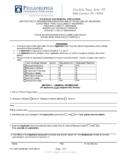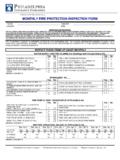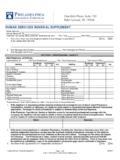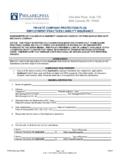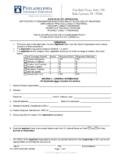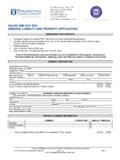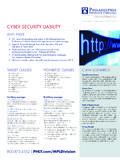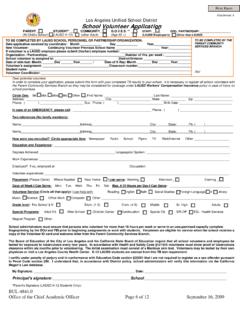Transcription of Volunteer Risk Management Guidebook - PHLY
1 MPORTANT NOTICE: The enclosed loss control information is for your consideration in your loss prevention efforts. They are not intended to be complete or definitive in identifying all hazards associated with your business, preventing workplace accidents, or complying with any safety related, or other, laws or regulations. You are encouraged to address the specific hazards of your business and to have your legal counsel review all of your plans and company policies. 1 Volunteer Risk Management Guidebook PIC Loss Control Services 2 TABLE OF CONTENTS 1. WHY YOUR ORGANIZATION NEEDS Volunteer RISK Management 3 2. THE LEGAL RAMIFICATIONS OF VOLUNTEERS AND VOLUNTEERING 4 3. THE IMPORTANCE OF DEVELOPING Volunteer WORK DESCRIPTIONS AND POLICIES 6 Volunteer Job Descriptions: 7 Volunteer Code of Conduct: 7 Sample Child Abuse Prevention Policy and Procedures 7 Elements of a Child Abuse Prevention Risk Management Program (This applies to both Volunteers and employees) 8 Abuse Prevention Training 9 Volunteers who may drive on behalf of the Organization 10 Driver Selection- Review of MVR records 10 Driver Training 11 Why your Organization should perform screening and background checks of Volunteers 11 5.
2 CREATING YOUR OWN Volunteer HANDBOOK 12 6. PHILADELPHIA INSURANCE COMPANIES TRAINING PROGRAMS AND RESOURCES 13 7. SAMPLE FORMS AND POLICIES 16 3 1. Why your Organization needs Volunteer Risk Management Volunteers are often a necessary part of a Non Profit Organization s operational mission. While in the past, many organizations would allow most volunteers to participate, given the current legal ramifications, a poorly screened and implemented Volunteer can present a huge liability to your Organization. This liability can drain your resources and also reflect negatively on the Organization s good name. Volunteers may have a highly visible role; they are often the people with whom the clients being served interact most closely. In addition, volunteers who are injured on your premises, even if they caused the injury, will be covered under your general liability policy as they are not employees. Let s examine a few examples of Volunteer Liability Claims: A.
3 Case one- A Volunteer , as part of his or her duties, transports clients or other volunteers in their own personal car. On the way to their destination, they are involved in an auto accident and they are held at fault. The passengers in the car sustain injuries. Your NP organization then discovers that the Volunteer was driving with a suspended license and had no insurance! Is the NP organization liable under their auto policy? Generally the answer will be yes if you have purchased an auto liability insurance policy. Indeed, even if the Volunteer has their own policy, it may exclude business activities such as volunteering. In the case above, the NP Organization failed to run Motor Vehicle Record, check the driver s license and require proof of insurance, thus opening the Organization up to litigation. B. Case Two A Volunteer tutors children after school. They are primarily alone with the child, often in a one on one setting.
4 A parent sues the NP organization alleging that their child was abused. Upon further investigation it appears that the Volunteer has been convicted in another state of an abuse related crime. Is the NP organization liable? Yes, the organization failed to properly screen the Volunteer . A background check of the individual would have brought to light the prior conviction. Note that the Cost of Defense for this type of suit is generally high. C. Case Three A Volunteer offers to do maintenance on the NP Organization building. He is unsupervised and decides to clean out the roof gutters. He falls off of a ladder and breaks his hip. He isn t covered by private insurance and also sues the organization maintaining that the ladder was not in good condition. Is the NP organization liable? Yes, they would be liable under the General Liability policy because he did not sign a hold harmless waiver indemnifying the NP Organization.
5 4 2. The Legal Ramifications of Volunteers and Volunteering This is broad topic and is also dependent on individual State Law so only the basics will be covered in this section. There are several types of Volunteers in the law. For the purposes of this handbook, the main types will be discussed; A Pure Volunteer This is what we typically think of when discussing a Volunteer . Per Wikipedia: A Volunteer is someone who works for free serves in a community or for the benefit of natural environment primarily because they choose to do so. The word comes from Latin, and can be translated as will; as in doing something for ones own free will. Many serve through a non-profit organization sometimes referred to as formal volunteering, but a significant number also serve less formally, either individually or as part of a group. By definition, a Volunteer worker does not get paid or receive compensation for services rendered other than reimbursement for out-of-pocket expenses.
6 Mandatory Volunteer A person who thru a school requirement or sentencing requirement performs community service in which the primary motivator is external to the individual when people are mandated to serve an authority. Directors and Officers of Nonprofit Corporations These volunteers own a higher obligation of duty to the NP Organization and the people it serves. Directors and Officers agree to be bound by these higher standards when they accept the positions. It is important that Directors and Officers self regulate to avoid not being in compliance with governmental regulations and the risk being held liable for the operations or possible mismanagement of the organization. Professionals Acting as Volunteers Often NP Organizations use the talents of Accountants, Dentists, Doctors and other professionals who donate their expertise. They are also held to a higher standard than the Pure Volunteer . There are a few ways that volunteers and NP Organizations including their Directors and Officers can be held liable for damages; For breach of duty imposed by common law, aka tort law.
7 1. For breach of duty imposed by statue, which is a crime or offense. 2. For breach of duty imposed by an agreement or contract. 5 Agreement and Waiver Volunteers should always sign an agreement and release from liability. This document sets down in writing the organization rules and helps defend the Organization from liability in the event that the Volunteer is injured, or involved in a traffic accident while performing on behalf of the Organization. Refer to the below example This form is also available in the forms section. 6 3. The Importance of Developing Volunteer Work Descriptions and Policies For your volunteers to be able to assist properly with your organization s mission, they need to be clear about the scope of what they will be doing. They also need to be trained in both the Organization s policies and specifically in their duties. For legal and accountability reasons, it is important for nonprofit agencies to have policies which protect the agency, its staff, clients/patrons, and volunteers.
8 Policies When developing your policies the following should be taken into consideration: General Considerations: Are there any foreseeable risks involved with the Volunteer program/agency as a whole? Can these risks be minimized? How? Would a policy bring clarity to a particular issue, such as expectations of volunteers or staff and Volunteer roles? Are there unwritten assumptions or values that should be expressed in policy, for clarity? Is there an action plan and/or timeline, for developing and implementing policies? How will Volunteer input be used when defining policy? Confidentiality: If you have Volunteers sign confidentiality statements, are they clear and understandable? Does your staff review the reasons why confidentiality is important to the Organization? Training and Safety Precautions It should be made clear to all Volunteers that there is an expectation that they will work safely and take steps to orient themselves to their environment.
9 They should be trained in the location of the fire extinguishers, fire escapes and exits and the procedure of how to deal with injuries. 7 Volunteer Job Descriptions: A job description is prepared for committee chairs, committee members with specific jobs, and other Volunteer positions as needed. Ideally, a job description is provided to the prospective Volunteer before he/she is asked to make a commitment. A sample job description form is located in the sample form section. Volunteer Code of Conduct: It is important that your organization clearly states what conduct is or isn t appropriate while participating as a Volunteer . A sample code of conduct form is located in the sample form section. Sample Child Abuse Prevention Policy and Procedures Child abuse happens to children of all ages from birth though adolescence and does not discriminate between gender, race, geography, or socio-economic or cultural groups.
10 Our policyholders should have an existing documented child abuse prevention program which include the below items as a minimum: (Note: If the Organization doesn t have a formalized documented program it should be taking the proper risk Management steps towards reducing this exposure. To help achieve the desired result of completely eliminating child abuse, top Management should begin the risk Management process by effectively planning, organizing, leading and controlling all aspects of the child abuse program. The organization should begin by organizing their child abuse prevention strategies into four categories. These 4 categories include Personnel, Program, Premises, and Participants. Then though implementation of the 5 Steps of the Risk Management Process (Identify, Evaluate, Select, Implement, and Monitor) the exposures associated from all 4 elements will help ensure a safer environment for children.) 8 Elements of a Child Abuse Prevention Risk Management Program (This applies to both Volunteers and employees) These steps should include, but not be limited to the following: 1.



